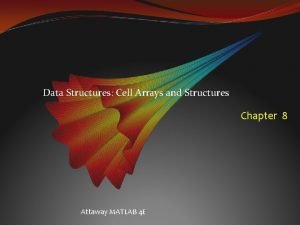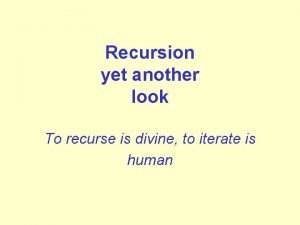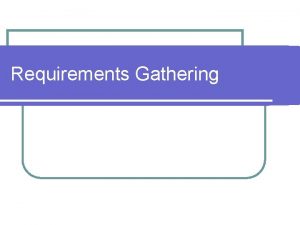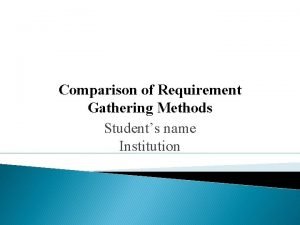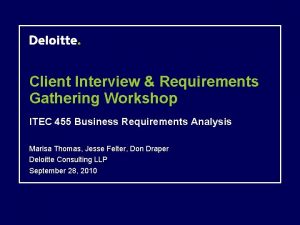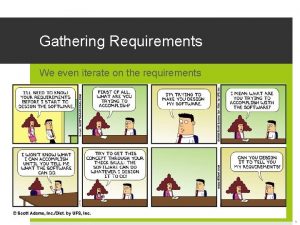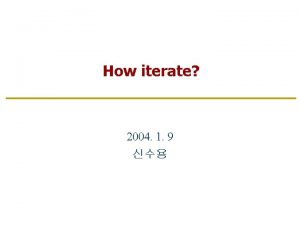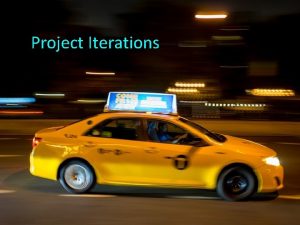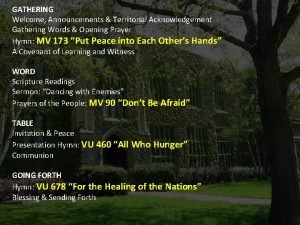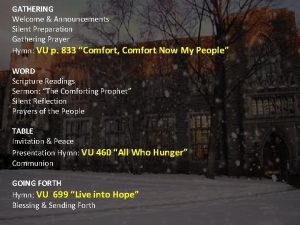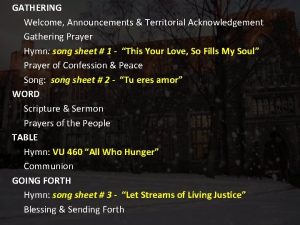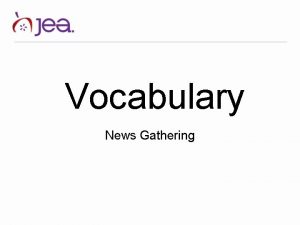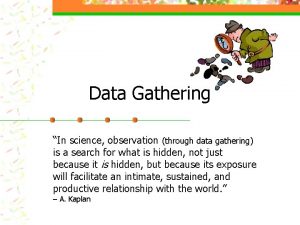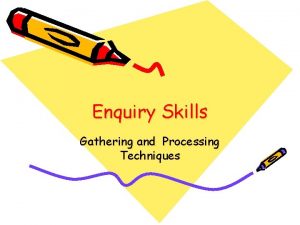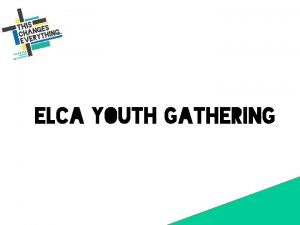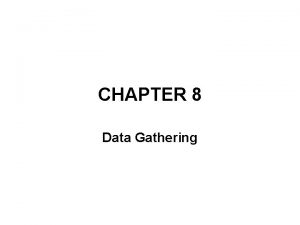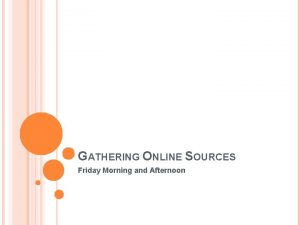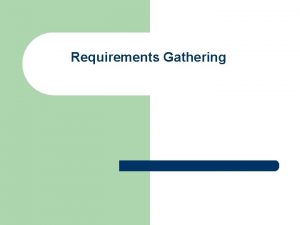Gathering Requirements We even iterate on the requirements





















- Slides: 21

Gathering Requirements We even iterate on the requirements 1

Gathering Requirements Did I say more iteration? I meant to. 2

Requirements are iterated 3

Not the same as phase iterations Iterate from ill-defined to defined Rather than a new set of requirements each iteration Repeat on same items until you get them right 4

Avoiding this project nightmare 5

Goals of Requirements Gathering All the requirements Well understood Time estimates that you’re confident in No Assumptions Same as ambiguity here 6

The Requirements Cycle (Process, Algorithm) lack of clarity = ambiguity = assumption Includes removing assumptions 7

Removing Assumptions is Hard They’re invisible… Comforting… Unspoken… Effortless. You should do this. 8

Take-Aways “Development” = Requirements process/algorithm 1. Capture basic ideas 2. Bluesky brainstorming 3. Construct user stories 4. Iterate on clarity w/customer 5. Refine user stories 6. Estimate with planning poker 7. a. Missing info from customer b. Test your assumptions c. Break up large user stories 8. Estimate all requirements NO ASSUMPTIONS • Iterate with customer • Test your assumptions 9

Blueskying Why do we “Bluesky” with all stakeholders? A. Experts at what they want B. Unique points of view, think of different things C. They’re paying D. Reduces stakeholder assumptions E. More people, more new ideas Inclusive process avoids tensions and alienation. 10

Estimation Why don’t we wait to estimate the user stories until the planning phase? It would help us focus on just what the requirements are, which is hard enough. A. Identify stories that are too big and split B. Helps get rid of assumptions right away C. Helps prioritize features, cost/benefit D. All are right, but B is the most central 11

What’s wrong with this user story? “The user will be able to click on an item and have javascript dynamically expand the item to show the item’s details. ” A. B. C. D. • It mentions technical details (Javascript). User stories are written in customer language. • Because this user story has an “and” in it, you might think it could be broken into two user stories, but this is a colloquial use of “and” that means “causing”. This user story is not too big. 13

Requirement to User Stories: ambiguity and refinement “my. City is a mobile app where you can see your my. City friends on a map, allowing you to message a nearby friend. ” 3. Initial User Stories: Commentary: • Some of these read more like “blueskying” (step 2), such as connecting to FB. Great idea, but maybe out of scope. Could come out in clarification phase (step 4). filtering: by distance, groups • Others are probably down the line (filtering) visibility/access permissions • Others might be too detailed at this stage, but certainly might happen (zooming, login). They might come out in the refinement step (5), or during the planning phase as a task. Scroll & zoom the map Login Link account to facebook Status: class, driving, work Writing/receiving msgs – 2 stories 14

A couple of user stories Display map with user at the center (H) Show friends on the map (H) Click on friends, get a textbox, type & send msg (H) Map continues to track user’s changing location (M) Map updates with coming and going of friends (M) Commentary: continuing to track user’s location might include a feature to allow setting the map view away from the user’s location (i. e. , not tracking the user’s loc. ) 15

my. City requirements, continued “my. City is a mobile app where you can see your my. City friends on a map, allowing you to message a nearby friend. ” 4. Finding Holes in Clarity: What’s nearby – city block to a mile Standalone, or leverage existing friend systems Google. Talk Message multiple people at once? Comm. with Google. Talk substrate Commentary: these are awesome questions for removing ambiguity. Birds-eye map or street-level birds-eye, but really whatever Google/Android give you Android-only How do we deal with lots of buddies nearby? How show friends on map – icon, photo, etc. ? 16

my. City requirements, continued “my. City is a mobile app where you can see your my. City friends on a map, allowing you to message a nearby friend. ” 5. Refine User Stories (refinements in bold): Display birds-eye map with user at the center (H) Don’t worry about scalability issues right now (lots of buddies) Show buddy handle on map Show Google. Talk friends on the map (H) Click on friends, get a textbox, type & send msg (H) No broadcast right now, but good idea for later map and buddy list, don’t have to message from map Map continues to track user’s changing location, with option to not track (M) Map updates with coming and going of friends (M) 17

my. City requirements, continued 6. Play Planning Poker (1 user story) Display birds-eye map with user at the center (H) A. 2 person-days (2 people, 8 hours each) B. 4 person-days C. 6 person-days D. 10 person-days E. 16 person-days 18

my. City requirements: exercise at home “my. City is a mobile app where you can see your my. City friends on a map, allowing you to message a nearby friend. ” 7 a-b. Get missing info, test assumptions: 19

my. City requirements: exercise at home 7 c. Break up large user stories 20

my. City requirements: exercise at home 8. Estimate all requirements 21

Take-Aways from Class Today Blueskying Brings in stakeholders beyond customer Stakeholder = anyone affected by the project Both technical (miss something) and political (piss someone off) Assumptions are a (hidden) form of: Non-communication with customer Technical uncertainty (skill, difficulty, …) Risk Iteration is once again the solution Iterate on user stories until assumptions are removed Iterate with customer, selves, and in planning game (estimation) Good user stories are tricky, and so is estimation. Practice makes perfect! 22
 Iterate
Iterate Iterate through cell array matlab
Iterate through cell array matlab Flowchart loop counter
Flowchart loop counter To iterate is human to recurse divine
To iterate is human to recurse divine Requirements gathering interview questions
Requirements gathering interview questions Agile methodology
Agile methodology Ux requirements gathering
Ux requirements gathering Requirements gathering workshop agenda
Requirements gathering workshop agenda Data warehouse requirements gathering
Data warehouse requirements gathering Language definition
Language definition Regular expression of even even language
Regular expression of even even language đại từ thay thế
đại từ thay thế Vẽ hình chiếu vuông góc của vật thể sau
Vẽ hình chiếu vuông góc của vật thể sau Quá trình desamine hóa có thể tạo ra
Quá trình desamine hóa có thể tạo ra Công thức tiính động năng
Công thức tiính động năng Thế nào là mạng điện lắp đặt kiểu nổi
Thế nào là mạng điện lắp đặt kiểu nổi Lời thề hippocrates
Lời thề hippocrates Dot
Dot Bổ thể
Bổ thể Vẽ hình chiếu đứng bằng cạnh của vật thể
Vẽ hình chiếu đứng bằng cạnh của vật thể độ dài liên kết
độ dài liên kết Các môn thể thao bắt đầu bằng tiếng chạy
Các môn thể thao bắt đầu bằng tiếng chạy

